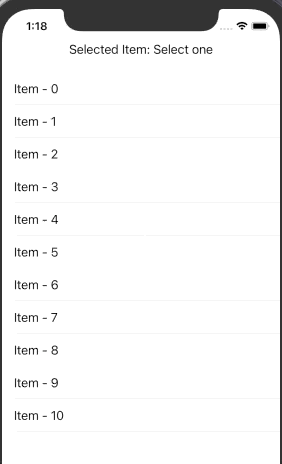I am creating single selection list to use in different places in my app.
Questions:
Is there an easy solution I don't know?
If there isn't, how can I finish my current solution?
My goal:
My current solution looks like: List view with second item selected
I can't use Picker, because outer action (goal Nr. 3) is time consuming. So I think it wouldn't work smoothly. Most probably there is solution to my problem in SwiftUI, but either I missed it, because I am new to swift or as I understand not everything works perfectly in SwiftUI yet, for example: transparent background for List (which is why i needed to clear background in init()).
So I started implementing selection myself, and stoped here: My current solution does not update view when item(Button) is clicked. (Only going out and back to the page updates view). And still multiple items can be selected.
import SwiftUI
struct ModuleList: View {
var modules: [Module] = []
@Binding var selectionKeeper: Int
var Action: () -> Void
init(list: [Module], selection: Binding<Int>, action: @escaping () -> Void) {
UITableView.appearance().backgroundColor = .clear
self.modules = list
self._selectionKeeper = selection
self.Action = action
}
var body: some View {
List(){
ForEach(0..<modules.count) { i in
ModuleCell(module: self.modules[i], action: { self.changeSelection(index: i) })
}
}.background(Constants.colorTransparent)
}
func changeSelection(index: Int){
modules[selectionKeeper].isSelected = false
modules[index].isSelected = true
selectionKeeper = index
self.Action()
}
}
struct ModuleCell: View {
var module: Module
var Action: () -> Void
init(module: Module, action: @escaping () -> Void) {
UITableViewCell.appearance().backgroundColor = .clear
self.module = module
self.Action = action
}
var body: some View {
Button(module.name, action: {
self.Action()
})
.frame(minWidth: 0, maxWidth: .infinity, alignment: .center)
.modifier(Constants.CellSelection(isSelected: module.isSelected))
}
}
class Module: Identifiable {
var id = UUID()
var name: String = ""
var isSelected: Bool = false
var address: Int
init(name: String, address: Int){
self.name = name
self.address = address
}
}
let testLines = [
Module(name: "Line1", address: 1),
Module(name: "Line2", address: 3),
Module(name: "Line3", address: 5),
Module(name: "Line4", address: 6),
Module(name: "Line5", address: 7),
Module(name: "Line6", address: 8),
Module(name: "Line7", address: 12),
Module(name: "Line8", address: 14),
Module(name: "Line9", address: 11),
Module(name: "Line10", address: 9),
Module(name: "Line11", address: 22)
]
Tried adding @State array of (isSelected: Bool) in ModuleList and binding it to Module isSelected parameter that MIGHT update view... But failed then populating this array in init(), because @State array parameter would stay empty after .append()... Maybe adding function setList would have solved this, and my goal Nr. 4. But I was not sure if this would really update my view in the first place.
struct ModuleList: View {
var modules: [Module] = []
@State var selections: [Bool] = []
init(list: [String]) {
UITableView.appearance().backgroundColor = .clear
selections = [Bool] (repeating: false, count: list.count) // stays empty
let test = [Bool] (repeating: false, count: list.count) // testing: works as it should
selections = test
for i in 0..<test.count { // for i in 0..<selections.count {
selections.append(false)
modules.append(Module(name: list[i], isSelected: $selections[i])) // Error selections is empty
}
}
var body: some View {
List{
ForEach(0..<modules.count) { i in
ModuleCell(module: self.modules[i], action: { self.changeSelection(index: i) })
}
}.background(Constants.colorTransparent)
}
func changeSelection(index: Int){
modules[index].isSelected = true
}
}
struct ModuleCell: View {
var module: Module
var Method: () -> Void
init(module: Module, action: @escaping () -> Void) {
UITableViewCell.appearance().backgroundColor = .clear
self.module = module
self.Method = action
}
var body: some View {
Button(module.name, action: {
self.Method()
})
.frame(minWidth: 0, maxWidth: .infinity, alignment: .center)
.modifier(Constants.CellSelection(isSelected: module.isSelected))
}
}
struct Module: Identifiable {
var id = UUID()
var name: String = ""
@Binding var isSelected: Bool
init(name: String, isSelected: Binding<Bool>){
self.name = name
self._isSelected = isSelected
}
}
let testLines = ["Line1","Line2","Line3","Line4"
]
To begin, create a SwiftUI Xcode project, and create a struct , namely, Data . Let's get back in our ContentView. swift and populate some values into this struct . Now, inside your view, create a List, and use ForEach to add and see all your data in list form.
SwiftUI displays the search bar under the navigation bar title and above the list that you'll filter. In multi-column view, you can choose in which view to display your search bar.
Here is a more generic approach, you can still extend answer according to your needs;
TLDR
https://gist.github.com/EnesKaraosman/d778cdabc98ca269b3d162896bea8aac
Detail
struct SingleSelectionList<Item: Identifiable, Content: View>: View {
var items: [Item]
@Binding var selectedItem: Item?
var rowContent: (Item) -> Content
var body: some View {
List(items) { item in
rowContent(item)
.modifier(CheckmarkModifier(checked: item.id == self.selectedItem?.id))
.contentShape(Rectangle())
.onTapGesture {
self.selectedItem = item
}
}
}
}
struct CheckmarkModifier: ViewModifier {
var checked: Bool = false
func body(content: Content) -> some View {
Group {
if checked {
ZStack(alignment: .trailing) {
content
Image(systemName: "checkmark")
.resizable()
.frame(width: 20, height: 20)
.foregroundColor(.green)
.shadow(radius: 1)
}
} else {
content
}
}
}
}
And to demonstrate;
struct PlaygroundView: View {
struct Koko: Identifiable {
let id = UUID().uuidString
var name: String
}
var mock = Array(0...10).map { Koko(name: "Item - \($0)") }
@State var selectedItem: Koko?
var body: some View {
VStack {
Text("Selected Item: \(selectedItem?.name ?? "Select one")")
Divider()
SingleSelectionList(items: mock, selectedItem: $selectedItem) { (item) in
HStack {
Text(item.name)
Spacer()
}
}
}
}
}
Final Result 
The easiest way to achieve this would be to have @State in the View containing the list with the selection and pass it as @Binding to the cells:
struct SelectionView: View {
let fruit = ["apples", "pears", "bananas", "pineapples"]
@State var selectedFruit: String? = nil
var body: some View {
List {
ForEach(fruit, id: \.self) { item in
SelectionCell(fruit: item, selectedFruit: self.$selectedFruit)
}
}
}
}
struct SelectionCell: View {
let fruit: String
@Binding var selectedFruit: String?
var body: some View {
HStack {
Text(fruit)
Spacer()
if fruit == selectedFruit {
Image(systemName: "checkmark")
.foregroundColor(.accentColor)
}
} .onTapGesture {
self.selectedFruit = self.fruit
}
}
}
If you love us? You can donate to us via Paypal or buy me a coffee so we can maintain and grow! Thank you!
Donate Us With